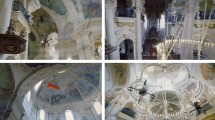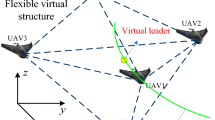Abstract
This paper treats the problem of position formation flight control of a group of three multirotor aerial vehicles under obstacle and collision avoidance constraints. In order to solve the problem, a distributed architecture with model predictive controllers for each vehicle includes a set of convex constraints on the vehicles’s position to prevent collisions with other vehicles and obstacles. The resulting distributed scheme controls the formation based on a virtual structure approach where the computers of the architecture exchange position data through diagrams in Simulink. The performance of the method is assessed through simulations considering that the vehicles are subject to disturbance forces and the results show the effectiveness and the ability of the control architecture to handle the obstacle and collision avoidance constraints.











Similar content being viewed by others
References
Richards, A., & How, J. (2002). Aircraft trajectory planning with collision avoidance using mixed integer linear programming. In Proceedings...American control conference. Piscataway: IEEE.
Ailon, A., & Arogeti, S. (2013). Formation control strategies for autonomous quadrotor-type helicopters. In Proceedings...2nd IFAC workshop on research, education and development of unmanned aerial systems (pp. 324–329).
Bemporad, A., & Morari, M. (1999). Control of systems integrating logic, dynamics, and constraints. Automatica, 35, 407–427.
Chao, Z., Ming, L., Shaolei, Z., & Wenguang, Z. (2013). Collision-free uav formation flight control based on nonlinear mpc. In Proceedings...2011 international conference on electronics, communications and control (ICECC) (pp. 1951–1956).
Chuang, J. H. (1998). Potential-based modeling of threedimensional workspace for obstacle avoidance. IEEE Transaction on Robotics and Automation, 14, 778–785.
Chung, H. (2006). Autonomous formation flight of helicopters: Model predictive control approach. Ph.D thesis, California Institute of Technology.
Fu, Y., Soupin, P., Yu, X., Zhang, Y., & Cole, P. (2015). Sense and collision avoidance of unmanned aerial vehicles using geometric guidance and flatness approaches. In Proceedings....International conference on unmanned aircraft systems (ICUAS) (Vol. 1, pp. 601–606).
Hoffman, G. M., Waslander, S. L., & Tomlin, C. J. (2008). Quadrotor helicopter trajectory tracking control. In Proceedings...AIAA guidance, navigation and control conference and exhibit (Vol. 1). Honolulu, Hawaii.
IBM. (2009). Ibm ilog cplex v12.1: user’s manual for cplex.
Latombe, J. C. (1991a). Visibility graph method. Boston, MA: Kluwer academic publishers.
Latombe, J. C. (1991b). Robot motion planning. Boston, MA: Kluwer Academic Publishers.
Li, Q. (2014). Grey-box system identification of a quadrotor unmanned aerial vehicle. M.S.thesis, Delft University.
Maciejowski, J. M. (2002). Predictive control with constraints. Harlow: Prentice-Hall.
Miller, D. (2011). Open loop system identification of a micro quadrotor helicopter from closed loop data. M.S.thesis, University of Maryland.
Murray, W., & Dunbar, R. (2002). Model predictive control of coordinated multi-vehicle formations. In Proceedings...IEEE conference on decision and control (Vol. 1, pp. 4631–4636). Piscataway: IEEE.
Paul, T., Krogstad, T. R., & Gravdahl, J. T. (2008). Modelling of uav formation flight using 3d potential field. Simulation Modellings Practice and Theory, 16, 1453–1462.
Prado, I. A. A., & Santos, D. A. (2014). A safe position tracking strategy for multirotor helicopters. In Proceedings...22nd mediterranean conference on control and automation (MED) (pp. 1433–1439). Piscataway: IEEE.
Richards, A., How, J., Schouwenaars, T., & Feron, E. (2001). Plume avoidance maneuver planning using mixed integer linear programming. In Proceedings...AIAA guidance, navigation, and control conference and exhibit. Montreal, Canada.
Richards, A., Schouwenaars, T., How, J., & Feron, E. (2002). Spacecraft trajectory planning with avoidance constraints using mixed-integer linear programming. Journal of Guidance, Control and Dynamics, 25, 755–764.
Ryan, A., Zennaro, M., Howell, A., Sengupta, R., & Hedrick, J. K. (2004). An overview of emerging results in cooperative uav control. In Proceedings...IEEE conference on decision and control. (Vol. 1, pp. 602–607) Piscataway: IEEE.
Santos, D. A. (2013). Automatic position control of multirotor helicopters. Technical report, ESIEE Paris, Postdoctoral final report, ESIEE Paris.
Santos, D. A., & O. Saotome. (2013). Trajectory control of multirotor helicopters with thrust vector constraints. In Proceedings...21st mediterranean conference on Control and automation (MED) (pp. 375–379). Piscataway: IEEE.
Schouwenaars, T., Feron, E., & How, J. (2006). Multi-vehicle path planning for non-line of sight communication. In Proceedings...American control conference (Vol. 1, 6). Piscataway: IEEE.
Schouwenaars, T., Demoor, B., Feron, E., & How, J. (2001). Mixed integer programming for multi-vehicle path planning. In Proceedings...European control conference (pp. 2603–2608).
Shuster, M. D. (1993). A survey of attitude representations. Journal of the Astronautical Sciences, 41, 439–517.
Valavanis, K. (2007). Advances in unmanned aerial vehicles–state of the art the road to autonomy. Berlin: Springer.
Vivas, A., & Mosquera, V. (2005). Predictive function control of a puma robot. In Proceedings...ACSE. ACSE Conference.
Yu, X., & Zhang, Y. M. (2015). Sense and avoid technologies with applications to unmanned aircraft systems: Review and prospects. Progress in Aerospace Sciences, 74, 152–168.
Acknowledgements
The authors acknowledge the support of Conselho Nacional de Desenvolvimento Científico e Tecnológico (CNPq), by research project grant 475251/ 2013-0 and doctoral scholarship, and the Instituto Tecnológico de Aeronáutica (ITA) by the necessary support to realize the present work.
Author information
Authors and Affiliations
Corresponding author
Rights and permissions
About this article
Cite this article
Viana, Í.B., Santos, D.A.d., Góes, L.C.S. et al. Distributed Formation Flight Control of Multirotor Helicopters. J Control Autom Electr Syst 28, 502–515 (2017). https://doi.org/10.1007/s40313-017-0315-1
Received:
Revised:
Accepted:
Published:
Issue Date:
DOI: https://doi.org/10.1007/s40313-017-0315-1




